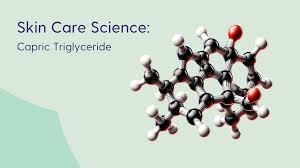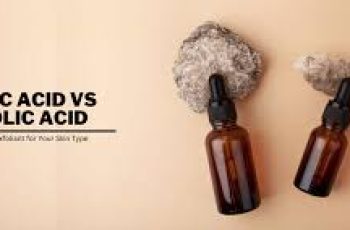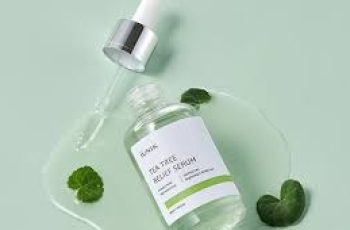The Science of Caprylic/Capric Triglyceride in Skin Care
If you’ve ever taken a look at the ingredient list on your favorite moisturizer or serum, you might have noticed the somewhat intimidating name “caprylic/capric triglyceride.” Despite its long, seemingly complicated name, this ingredient is nothing to worry about! Caprylic/capric triglyceride is often used in skin care and personal care products for its moisturizing capabilities, as well as a way to make products spread more easily or to thicken formulations to the perfect consistency.
You will find this ingredient in many of the best and most well-known skin care brands and products. Learn more about what it is, how it works, and where to find it in skin care.
Caprylic/capric triglyceride is commonly used as a moisturizing ingredient in skin care.
This ingredient also improves the spreadability, smoothness, and stability of skin care formulations.
Unlike coconut oil, from which it is derived, caprylic/capric triglyceride does not generally clog pores.
What Is Caprylic/Capric Triglyceride?
Triglycerides are molecules made up of three fatty acids attached to a glycerol backbone. In skin care, triglycerides are often included in products because they help your skin to retain moisture, while also improving the texture of the formulation itself.
Caprylic/capric triglyceride is derived from coconut oil and glycerin, both of which are plant-based, making this ingredient a popular choice in many natural and vegan-friendly skin care brands. The “caprylic” and “capric” parts of this ingredient refer to two types of fatty acids within the molecule: caprylic acid and capric acid. These fatty acids contribute to the lightweight and silky feel of this ingredient on the skin. Since it is derived from coconut oil, caprylic/capric triglyceride provides many of the benefits of coconut oil but is more stable and less likely to feel greasy.
Active Compounds in Caprylic/Capric Triglyceride
The main active components of caprylic/capric triglyceride are its medium-chain fatty acids: caprylic and capric acids. These two fatty acids contribute to this ingredient’s ability to moisturize and protect the skin, as well as creating smooth, spreadable formulas.
Caprylic acid, also known as octanoic acid, is an 8-carbon fatty acid with antibacterial and anti-inflammatory properties. Caprylic acid on its own has been shown to have anti-inflammatory and antibacterial benefits (3). Due to its molecular size, caprylic acid also helps o create smooth, lightweight formulas that do not feel greasy or heavy on the skin.
Capric acid, also known as decanoic acid, is another medium-chain fatty acid similar to caprylic acid, but with a 10-carbon chain. It shares many of the same properties as caprylic acid, with a few additional benefits. Capric acid has a slightly thicker molecular structure, which gives it a slightly richer feel while still being lightweight. This structure enables it to help seal moisture into the skin’s upper layers, improving hydration. It is also a very stable molecule and does not break down easily in light or heat, making it a beneficial stabilizing ingredient in skin care formulations.
Benefits of Caprylic/Capric Triglyceride in Skin Care
The main benefit of caprylic/capric triglyceride for the skin is its ability to moisturize. Below is a deeper dive into how this ingredient can improve your skin and the formulations of your skin care products.
Moisturizing. As an emollient, caprylic/capric triglyceride forms a protective barrier over the skin to lock in moisture, making it especially beneficial for dry skin types.
Smoothing texture. Caprylic/capric triglyceride improves the texture of skin care products, helping them spread more easily and evenly across the skin.
Lightweight feel. Unlike some oils that can feel heavy or greasy, caprylic/capric triglyceride is lightweight, making it suitable for a wide range of skin types.
Non-comedogenic. While coconut oil is comedogenic (meaning it can clog pores) because it also contains lauric and oleic acids, caprylic/capric triglyceride is generally non-comedogenic because it lacks these components that are typically problematic for oily and acne-prone skin.
Improved product stability. This ingredient can also help to stabilize products, preventing them from separating and extending their shelf life.
Side Effects of Caprylic/Capric Triglyceride in Skin Care
One of the reasons caprylic/capric triglyceride is so widely used in skin care is because it generally comes with little to no side effects when applied topically and doesn’t often cause irritation or allergic reactions.
Products with Caprylic/Capric Triglyceride
You’ll find this moisturizing and smoothing ingredient in everything from moisturizers to anti-aging creams to face masks. Just a few top products from brands you might already use that contain this ingredient are below.
Bottom Line: Is Caprylic/Capric Triglyceride Right for You?
Caprylic/capric triglyceride is found in many skin care products, and it’s likely you may already use a product or two with this ingredient and not even realize it! Caprylic/capric triglyceride can be a match for both dry and oily Baumann Skin Types – but it depends on what else is included in the formulation and what it is designed for. So you still want to make sure the product as a whole is a match for your skin type.
If you don’t know your Baumann Skin Type yet, take the quiz below so we can help you customize your skin care regimen based on your skin’s specific needs. You will then be able to see which products with caprylic/capric triglyceride are best for your skin type.
DQH Knowledge drop: In your 20s, your skin cell turnover decreases. (Cell turnover is a key component in keeping your skin youthful.) You know what else slows down? Your collagen production. Starting in your 20s, collagen decreases by about 1 percent per year. Should you want to prevent fine lines and wrinkles, start by eliminating behaviors that contribute to premature aging. “If it’s bad for you, it’s bad for your skin,” says dermatologist Michel Somenek.
“Cigarette smoking reduces blood flow to the skin and causes premature wrinkling and a dull skin texture. Making the repeated pursed motion to inhale can also cause smoker’s lines. Alcohol and recreational drugs are toxins for the skin that damage its cellular structure and DNA,” Somenek tells us. “The faster you eliminate vices while you are young, the better chance your skin and body have to recuperate.” Also, adopting an anti-aging routine in your 20s is key. After all, the best offense is a good defense. We spoke to Somenek and experts Joshua Ross and Audrey Kunin to find out more.
Keep reading for the best anti-aging products for your 20s, according to skincare professionals.
Sunscreen
“We all know that the sun is the number one cause of skin aging and starting the prevention in your 20s is very important,” Ross says. “The majority of your sun damage won’t start to appear until you’re in your 30s, so don’t wait until you see it surface or you’ll be behind the curve. Stay ahead of it with a good-quality zinc-based sunscreen worn daily.”
Farmacy Green Defense Daily Mineral Sunscreen
An invisible sunscreen with SPF 30, plus botanical extracts meant to protect skin with tons of antioxidants. Bonus: It’s clean and fine to use under makeup.
Bareminerals Complexion Rescue™ Tinted Moisturizer Broad Spectrum SPF 30
Although we recommend you use your SPF and moisturizer separately, we also understand moments when you don’t have time or energy for that extra step. For those times, this bareMinerals moisturizer is a great thing to have on hand.
Vitamin C Serum
“A great introduction to anti-aging is to start with a vitamin C serum in your morning skincare routine,” Ross says. “It’s a powerful antioxidant that will neutralize free radicals and brighten the skin.” He adds that it’s a great way to counteract the effects of the sun’s harmful rays, which, as previously mentioned, are among the biggest causes of premature aging.
Drunk Elephant C-Firma™ Vitamin C Day Serum
The Drunk Elephant C-Firma is a lightweight serum that promises to give skin a glow by combining the brightening powers of vitamin C with ferulic acid, l-ascorbic acid, and vitamin E. The included sodium hyaluronate is meant to replace hydration loss, so you shouldn’t have to deal with any irritation.
Sunday Riley C.E.O. Rapid Flash Brightening Serum
This potent serum is jam-packed with vitamin C (15 percent, to be exact), which means it’s a potential superstar at both brightening skin and dousing it in antioxidants.
Peptides
Using peptides on your skin has many benefits, says Somenek. “The skin barrier is what defends the body against pollution, UV rays, bacteria, and toxins. It can be damaged by several everyday factors. Using topical peptides aids in building a stronger barrier,” he says. “Peptides comprise elastic fibers, which are a type of protein. These fibers help to make skin appear taut and firm. Peptides can also help repair damaged skin, relieve inflammation, and even out skin tone. Some peptides can kill acne-causing bacteria that is common in 20-somethings.”
Kunin agrees, saying, “Peptides are an excellent entry point for supporting collagen.” She recommends looking for face and eye treatments that contain these collagen-boosting powerhouses.
Charlotte Tilbury Magic Eye Rescue Cream
This Charlotte Tilbury super-emollient eye cream has a base of coconut oil and shea butter (read: it’s incredibly hydrating). Botanicals plus peptides are meant to help reduce dark circles and boost collagen, respectively.
This creamy moisturizer serves up potent collagen-boosting peptides and pycnogenol, and antioxidant-rich vitamin C. “Instead of sitting on top of the skin, peptides penetrate the outer layer so they go deep. The ‘signals’ they send tell the cells to produce elastin and collagen, which are needed for youthful-looking skin,” explains Somenek.
At-Home Peel Pads
Remember that skin cell turnover fiasco we talked about earlier? One way to help support it is by exfoliating. “Exfoliation is important to help keep skin fresh and luminous,” Kunin says. She recommends using at-home peel pads as an easy and effective way to exfoliate.
“The goal in your 20s is to fight the slowing pace of cell turnover. It is wise to use products that gently exfoliate, yet still remove oil and other impurities. Products that have Alpha Hydroxy Acids (AHA) or Beta Hydroxy Acids (BHA) are a good choice.”
According to Somenek, you should only exfoliate two to three times a week. “People of all ages are guilty of over-exfoliating and that can be too much of a good thing,” he says.
Dermadoctor Kakadu C Intensive Vitamin C Peel Pad
A few swipes of this Derma Doctor powerful peel pad promise to leave your skin glowing and smooth, thanks to the seven (yes, seven) types of chemical exfoliants, including AHA and BHA. It also contains vitamin C via Kakadu plum extract for added brightening and antioxidant protection.
KEY INGREDIENTS Kakadu plum extract is sourced from the Kakadu plum, a fruit grown in northern Australia. It contains vitamin C, which restores the skin’s natural barrier, increases collagen production, and soothes irritation.
Dr. Dennis Gross Skincare Alpha Beta® Universal Daily Peel Pads
These are the gold standard of peel pads, with a cult following and over 900 five-star reviews on Sephora. They’re easy to use and contain a blend of anti-aging exfoliating acids.
Emollient Night Cream
“In your 20s, you need to start upping the hydration in your skincare routine. You may have been cautious of over-moisturizing because of acne in your teens, but as you enter your 20s, your skin transitions and becomes drier,” Ross says. “I recommend an emollient night cream added into your evening skincare regimen.”
“Twenty-somethings need to make sure that they are not using creams that will clog their pores and cause excess oil production,” says Somenek. Opt for non-comedogenic products.
Cerave Skin Renewing Night Cream
One great choice is the CeraVe Skin Renewing Night Cream, which is a non-comedogenic night cream that leaves skin soft and glowy. It combines the moisturizing powers of ceramides and hyaluronic acid.
RoC Retinol Correxion Max Hydration Creme
“The best night cream ingredients contain retinol, benzoyl peroxide, and/or salicylic acid or hyaluronic acid. The goal is to moisturize, yet remove excess oil,” says Somenek. This Roc Retinol Correxion cream fits the bill as it contains both hyaluronic acid and retinol so it promises to moisturize while also being non-comedogenic.



